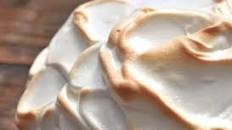The Delicate Delight of Meringue
When it comes to desserts that embody lightness, elegance, and a touch of sweetness, meringue stands out as a true culinary gem. This delicate confection, made primarily of whipped egg whites and sugar, has been enchanting taste buds for centuries with its airy texture and melt-in-your-mouth goodness.
One of the most fascinating aspects of meringue is its versatility. Whether it’s baked into crisp shells for pavlovas and pies, piped into whimsical shapes for cookies and kisses, or folded into mousses and soufflés for added fluffiness, meringue can adapt to a myriad of culinary creations.
The magic of meringue lies in the art of whipping egg whites to achieve stiff peaks while gradually incorporating sugar to create a stable yet luscious foam. The resulting mixture can be flavored with vanilla, citrus zest, cocoa powder, or even nuts to add depth and complexity to its ethereal taste.
From the classic French meringue to the more stable Italian and Swiss varieties, each technique offers its own unique characteristics and applications in the pastry world. Whether you prefer your meringue soft and marshmallow-like or crisp and crackly, there’s a style to suit every palate.
Whether adorning a lemon meringue pie with billowing peaks of toasted sweetness or serving as a base for an indulgent Eton mess piled high with fresh berries and cream, meringue has the power to elevate any dessert from ordinary to extraordinary.
So next time you crave a dessert that’s light as air yet rich in flavor, consider indulging in the timeless allure of meringue. Its delicate charm is sure to leave you craving just one more heavenly bite.
Everything You Need to Know About Meringue: FAQs and Tips
- What is meringue?
- How is meringue made?
- What are the different types of meringue?
- What desserts can be made with meringue?
- How do you achieve stiff peaks when making meringue?
- Can meringue be flavored with other ingredients?
- How should meringue be stored to maintain its texture?
- Are there any common mistakes to avoid when making meringue?
What is meringue?
Meringue is a delectable confection crafted from whipped egg whites and sugar, known for its light and airy texture that practically dissolves on the tongue. This sweet treat can take on various forms, from crisp shells to fluffy clouds of sweetness, depending on the method of preparation. By whipping egg whites to stiff peaks and gradually adding sugar, meringue achieves a stable yet delicate foam that serves as a versatile base for an array of desserts. Whether baked into pies, piped into cookies, or folded into mousses, meringue adds a touch of elegance and sweetness to any culinary creation.
How is meringue made?
Meringue is crafted through a meticulous process that involves whipping egg whites to form stiff peaks before gradually incorporating sugar to create a glossy, stable foam. This technique allows the meringue to achieve its signature airy texture and delicate sweetness. Depending on the desired outcome, different types of meringue—such as French, Italian, or Swiss—can be prepared, each offering unique characteristics in terms of texture and application in various desserts. The art of making meringue lies in achieving the perfect balance of airiness and structure, resulting in a versatile confection that can be baked into crispy shells, piped into decorative shapes, or folded into luscious mousses.
What are the different types of meringue?
There are three primary types of meringue: French, Italian, and Swiss. French meringue is the simplest and most common, made by whipping egg whites until stiff peaks form, then gradually adding sugar. Italian meringue involves boiling sugar to create a syrup that is slowly poured into whipped egg whites, resulting in a stable and glossy mixture. Swiss meringue requires heating egg whites and sugar over a double boiler before whipping into a thick and velvety foam. Each type of meringue offers unique characteristics that cater to different culinary applications, from light and airy toppings to stable bases for various desserts.
What desserts can be made with meringue?
Meringue, with its airy texture and delightful sweetness, serves as a versatile component in a wide array of delectable desserts. From the classic and beloved lemon meringue pie to the elegant pavlova topped with fresh fruits and whipped cream, meringue shines as a key ingredient in creating show-stopping treats. It can also be transformed into delicate cookies known as meringue kisses, or folded into rich mousses for added lightness. Whether it’s serving as a crisp shell for pies, a topping for tarts, or an element in layered trifles, meringue adds a touch of sophistication and sweetness to any dessert it graces.
How do you achieve stiff peaks when making meringue?
To achieve stiff peaks when making meringue, it is essential to start with clean, grease-free equipment and room temperature egg whites. Begin by whipping the egg whites on low speed until they become frothy, then increase the speed gradually while adding sugar a little at a time. Continue beating until the mixture thickens and glossy peaks form when the beaters are lifted. The key is to not overbeat the meringue, as this can cause it to become dry and lose its smooth texture. With patience and attention to detail, mastering the art of achieving stiff peaks in meringue will elevate your desserts to new heights of lightness and elegance.
Can meringue be flavored with other ingredients?
Absolutely! Meringue is a versatile confection that can be infused with a variety of flavors to suit your preferences. From classic additions like vanilla extract and citrus zest to more adventurous choices such as cocoa powder, coffee extract, or even crushed nuts, the possibilities for flavoring meringue are virtually endless. By incorporating different ingredients during the mixing process, you can customize your meringue to create a unique taste experience that complements your desired dessert or treat. So go ahead and experiment with different flavor combinations to elevate your meringue creations to new heights of deliciousness!
How should meringue be stored to maintain its texture?
To maintain the delicate texture of meringue, it is essential to store it properly. Once prepared, meringue should be kept in an airtight container at room temperature in a cool, dry place. Avoid exposing meringue to moisture or humidity, as this can cause it to become sticky and lose its crispness. If storing meringue that has been baked or piped onto desserts, ensure that it is shielded from direct sunlight and any sources of heat to prevent it from becoming soggy. By following these storage guidelines, you can preserve the light and airy quality of meringue for optimal enjoyment.
Are there any common mistakes to avoid when making meringue?
When venturing into the realm of meringue-making, it’s essential to be mindful of a few common pitfalls that can hinder your success. One prevalent mistake to avoid is introducing any trace of fat, whether it be from egg yolks or greasy utensils, as it can prevent the egg whites from reaching their full voluminous potential. Additionally, overbeating the egg whites can lead to a grainy or deflated meringue, so it’s crucial to stop whipping once stiff peaks form. Lastly, baking meringues at too high a temperature or for too long can result in browning or cracking, detracting from their pristine appearance. By steering clear of these missteps and following a few key tips, you’ll be well on your way to mastering the art of creating flawless meringue delights.




